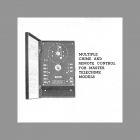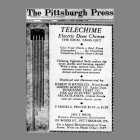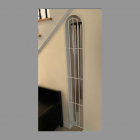Telechime Aristocrat Model 446

The Telechime Aristocrat is an elaborate musical door chime manufactured by General Kontrolor of Dayton, Ohio. This chime plays a series of unique melodies each time a caller pushes the doorbell. Up to eight different four-note melodies, or four eight-note melodies are provided depending on the preference of the homeowner. Most are variations of the Westminster quarters, although one sequence is from the then popular Irving Berlin song: “The Near Future” colloquially known as “How Dry I am.”
TeleChime products have a high build quality as they were engineered, and perhaps over-engineered, by Gisbert Bossard, a prolific inventor and founder of General Kontrolor. The Bakelite cover was designed by an anonymous designer at the Industrial Art Council of New York and awarded a design patent in 1931. The Aristocrat is among the very first multi-note long bell chimes brought to market.
Along with the other multi-note chimes in the Telechime line, the Aristocrat employs a remote sequencer to control a wall mounted array of solenoids which strike the tubular bells of varied lengths to play the melodies. A potentiometer controls the volume and a switch allows the selection of four or eight-note melodies. A small keyboard allows the Aristocrat to be used as a servants call or carillon. The wall unit supports the chime tubes and decorative cover. As was common with early chimes, the backs of the heavy duty solenoids are recessed thus allowing the tubes to hug the wall.
The Aristocrat was described in the 1936 Catalog:
Model No. 446—The ideal Master Chime signal. Meets all requirements of a complete signal system, code-call, dinner chime and musical carillon. Changeover switch plays a refrain of four or eight chime tones for front door; has six different chime refrains. Four individual chime actions and tones offer a wide choice of signal combinations. Multiple chime control mechanism. Semi-surface mounting. Choice of engraved Bakelite cover or aluminum black Morocco with chromium trim.
Perhaps more than any other manufacturer, Telechime promoted the use of their chimes for duties beyond announcing callers. The 1936 catalog begins:
Why Not A MUSICAL SERVANT IN YOUR HOME. These are a few of many practical pleasure giving and time-saving uses for Telechime:
as a paging system in your home,…. coded chimes call servants and members of the family…when visitors at the door press the button, chimes announce their presence…servants are summoned with a chime…Telechime musically announces a telephone call… the family can be agreeably awakened in the morning to sweet notes of Telechime…vespers and the dinner are heralded with beautiful cathedral chimes…more than 300 melodies are easily played without practice on a simple Telechime keyboard.
Note that this museum example differs slightly from the description above as it has eight four-note chime refrains instead of the six listed and the transformer is incorporated within the Master Controller unit. I believe this is an earlier model.
| Manufacturer | Telechime Division of General Kontrolor Co. Inc. |
| Location of Manufacture | Dayton, Ohio, USA |
| Date of Manufacture | Introduced 1931. Museum Example ~1934 |
| Cover | Bakelite |
| Mechanism | Stamped Steel |
| Bells | Nickel-Plated Brass |
| Height | 60 inches |
| Width | 7 3/4 inches |
| Depth | 3 3/4 inches from wall (~1 inch in wall) |
| Notes | ElectraChime Collection. Cover repaired and painted. Master Controller serviced. |


